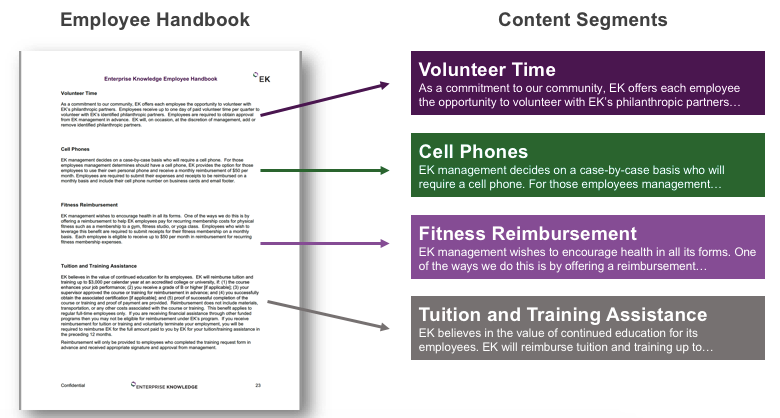At EK, one of our core tenets when considering content strategy, content architecture, and broader content management is the definition of “chewable chunks” of content. Our approach is to break content into smaller, more manageable pieces both for easier management as well as improved findability and usability. We refer to this process as “content deconstruction”.
The wide use of Microsoft Office has made it easy to create long, voluminous documents that can be stored as a PDF and published to your site. But think about how that document would be surfaced on your website or intranet. As an example, let’s take a document which is very common in all organizations – the employee handbook. Our EK handbook is 46 pages, and we’re not a large company.
Let’s suppose I’m interested in finding out more information about EK’s tuition assistance program – hmm, nice perk! My first step would be to search our intranet for a keyword like “tuition”. As expected, one of the top hits (if the relevance of the search results is tuned correctly) is the handbook.
The link in the results page opens the PDF, but not at a location that reinforces my search. I’m sitting and staring at the cover page of the handbook. Unfortunately, there’s nothing about tuition on the cover page. Therefore, I must either page down to the table of contents looking for information on tuition or do a find for “tuition” in the document until I get to the relevant section.
Our recommended approach would leverage your existing content management system to deconstruct the handbook into a series of smaller, more manageable records as opposed to a single lengthy document. Instead of surfacing the whole document, I now have the ability to display the individual sections on their own.
With these smaller, individual sections of content, I could apply tags – “tuition,” “professional development” – in a more granular, directed manner. Further, the links on my search results page will now take me directly to the relevant section of the handbook – “Tuition and Training Assistance” instead of opening a PDF. Finally, I have created a series of content that can be used similarly to Google’s featured snippets – blocks of relevant content that appear at the top of the search results page.

At EK, we recommend looking for several key characteristics to identify candidate documents for deconstruction. Characteristics to consider are:
- Length. The document size should be 20 or more pages.
- Structured, hierarchical. The document should have some structure or hierarchy that can easily be captured. It could be as simple as section headings, or as complex as a formal outline.
- Relevant. The document should be high-value. There is time and effort required to transform the document, and you probably won’t have the ability to transform all your documents. Use analytics or your own intuitive knowledge of your content to pick good candidates.
- Multiple audiences. Consider documents that have been written for multiple audiences. Often, we see content for a specific audience, included deep within a larger, broader document. Someone interested in this targeted content has to wade through multiple pages trying to find applicable content.
Overall for the organization, this translates to:
- Increased productivity. Smaller documents lead to more precise tagging which means workers are spending less time looking for content. Instead of adding a wide variety of tags to a single document, you can add a single tag to the specific content where it’s discussed.
- Improved findability. The search relevancy algorithms underlying most modern search engines work best when dealing with documents of similar size. Lengthy documents can negatively influence the results. This means users will spend less time looking for the right content and more time acting upon it.
- Enhanced usability. It’s much cleaner to display a few paragraphs within the context of an intranet instead of a large PDF which requires a viewer or takes you out of the site by opening a separate application. With deconstructed content chunks, users will spend less time sifting through documents and more time getting answers.
Overall, the replacement of large, unwieldy documents with a series of smaller, flexible sections will lead to more efficient content management and productivity, findability, and usability for the organization. In short, this means time and cost saved for the organization and higher levels of up-scaling, support, and learning for your end users.
Looking for help getting started? EK is here to help you start the deconstruction process! Contact us.
